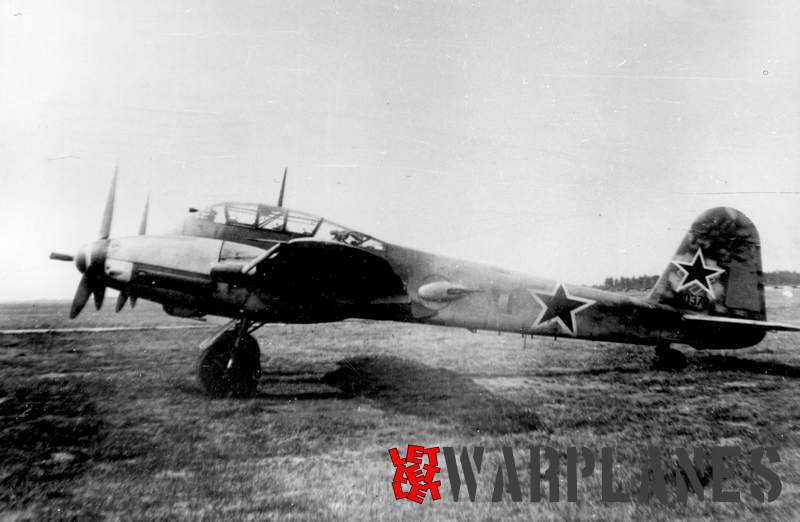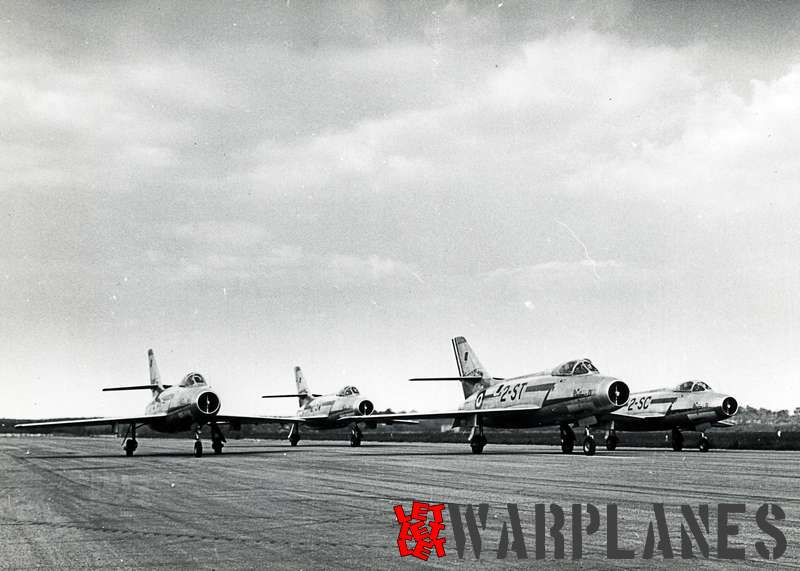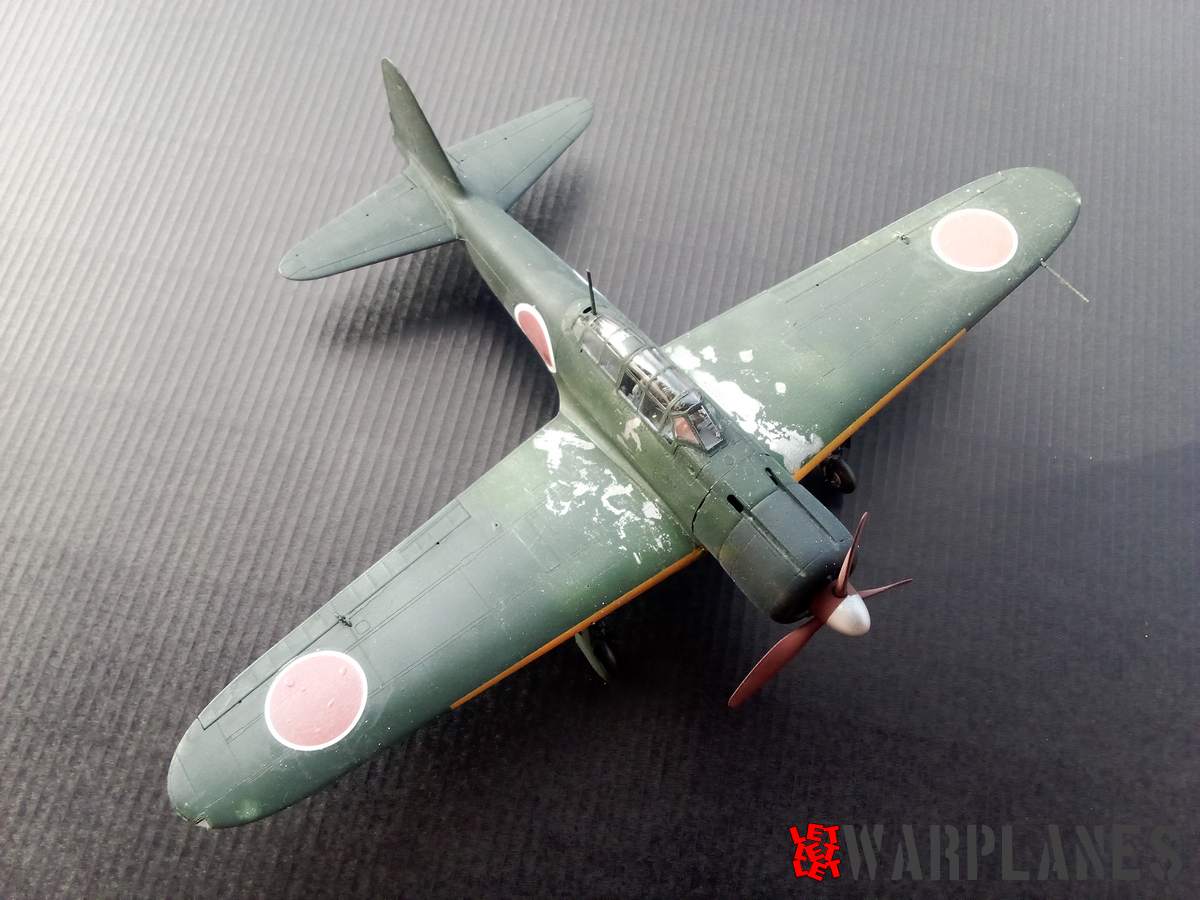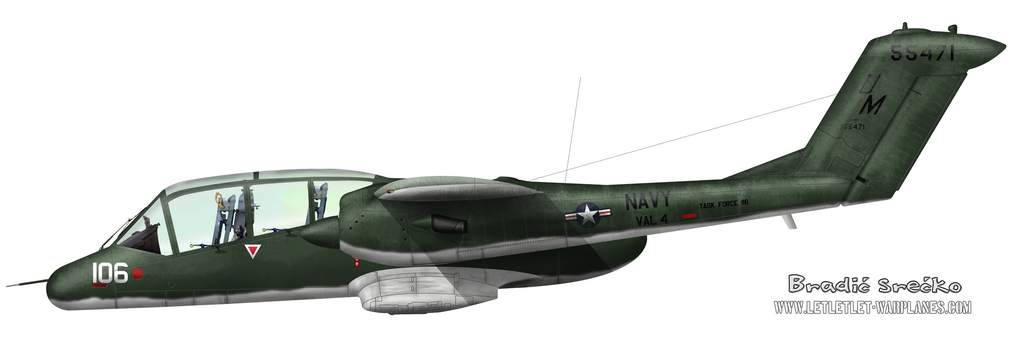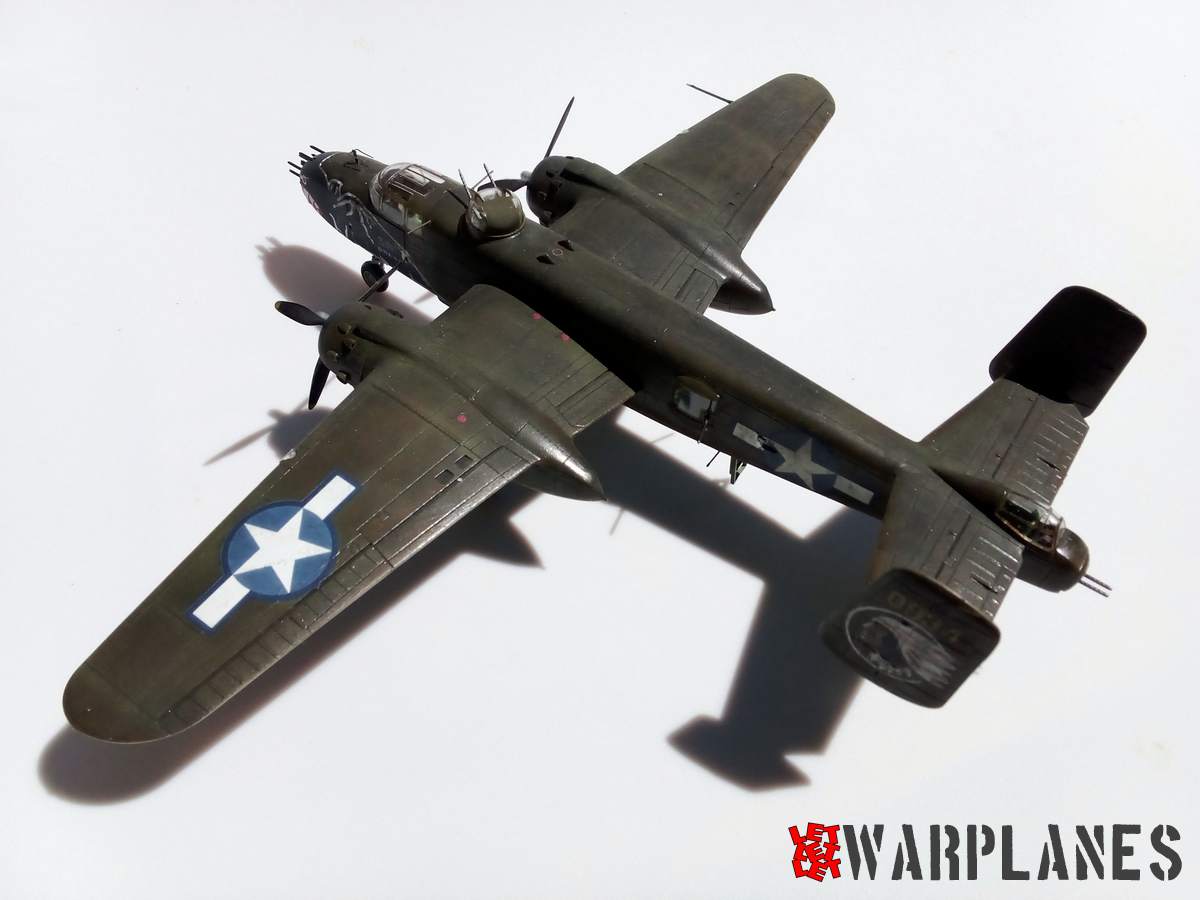Seahawk – the first Hawker jet fighter
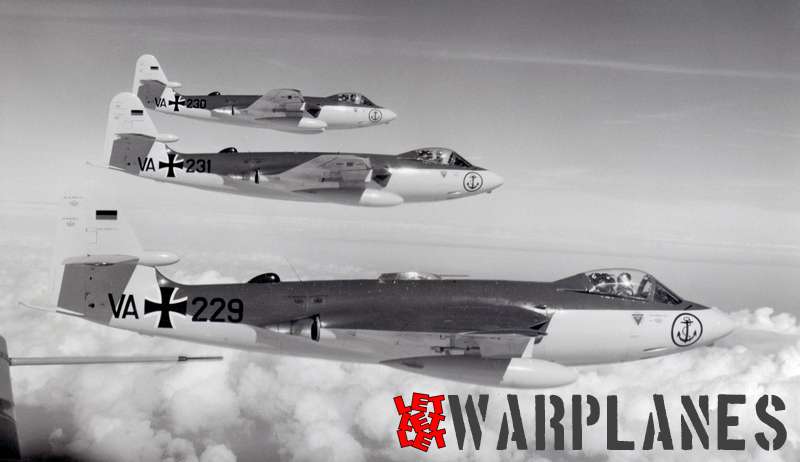
Introduction:
As early as 1944 Hawker’s design bureau, headed by Sidney Camm, started with a jet-powered successor of the Bristol Centaurus powered Fury fighter. This was at a point when the first details of the new Rolls Royce B.41 jet engine became available, later to be known as the Nene. Initially Camm’s team adapted the Fury design for the new jet engine with the engine placed in the centre section and the exhaust pipe in the aft fuselage. Two side air intakes provided the breathing of the jet engine. Known as the Hawker P.1035, it had much in common with the Gloster E.1/44 and with the Vickers-Supermarine E.10/44 prototype that became later known as the Attacker shipboard fighter. However, Hawker developed in collaboration with Rolls Royce a split tailpipe schema that offered many advantages. The original jet-plane design was adapted for the installation of this bifurcated jet pipe exhaust system and became known as the Hawker P.1040. It was the beginning of one of the best handling early jet fighters of the U.K.: the Sea Hawk.

Early design and development:
The Hawker P.1040 project resulted in October 1945 in a contract for the manufacturing of a prototype. Originally it was meant both for the Royal Air Force and the Royal Navy, but the R.A.F. soon withdrew their support since they saw no advantages of the new Hawker jet fighter over the Gloster Meteor IV, which had just set a world speed record of 975 km/h.
However, the Royal Navy remained interested in the P.1040 as a shipboard fighter. It perfectly filled Specification N.7/46 for such a fighter.
Flight testing/Rocket experiments:
The P.1040 prototype made its first flight on 2 September 1947 at Boscombe Down. Test pilot on this occasion was Bill Humble. During the early flight testing severe buffeting was experienced. To cure this an acorn fairing was placed at the intersection of tailplane and fin. Also other teething problems were all ironed out without great problems and in general the P.1040, carrying the serial VP401, was found to have excellent handling properties with a great manoeuvrability. VP401 was as a future naval fighter not yet fitted with folding wings, an arrester hook and armament; it purely served as a research vehicle!
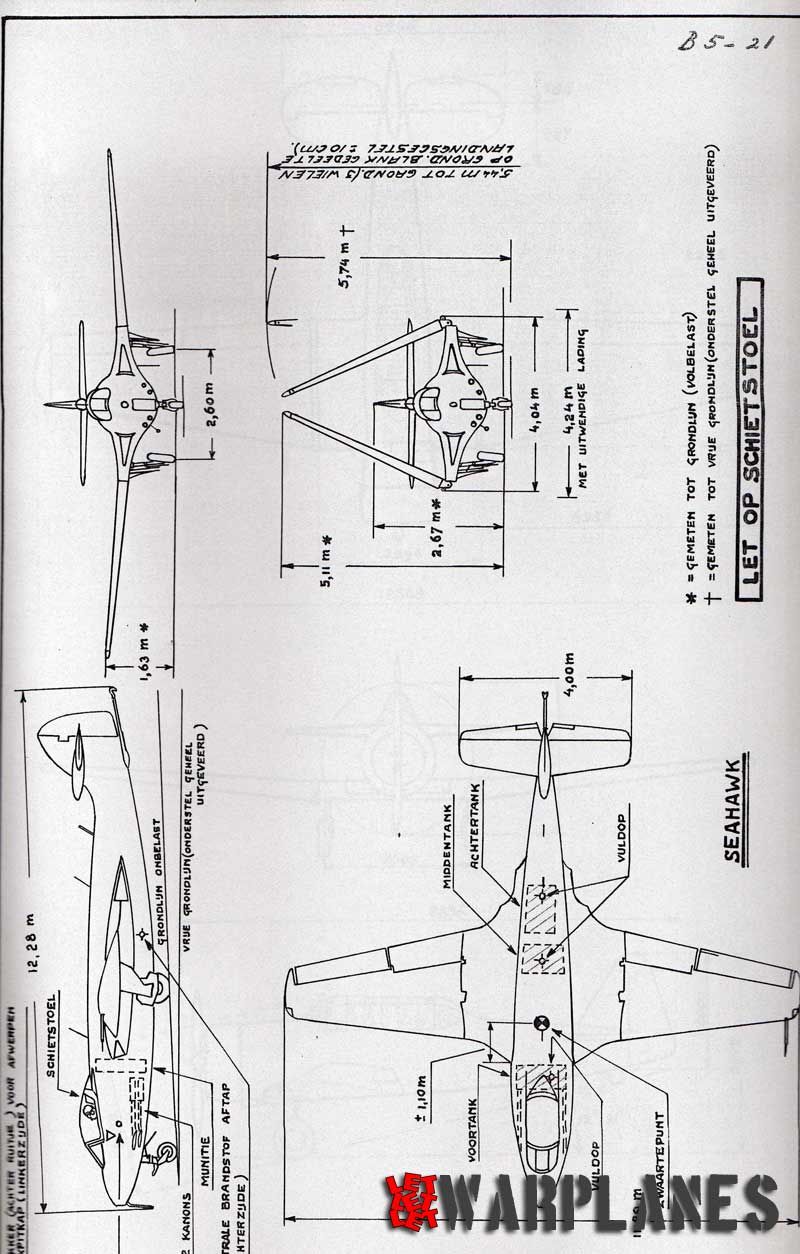
VP401 was flown in the National Air Races and on 1 August 1949 Sqn. Ldr. Wade won the SBAC Challenge Cup at Elmdon at a speed of 821 km/h. By September 1949 the plane had completed its development program and was then return to the Hawker works at Kingston-upon-Thames for modifications to include a rocket engine in the tail.
When Armstrong Siddeley produced by end 1947 a 2000 lbs (907.4 kg) thrust rocket engine that was found to be quite reliable, Hawker proposed to modify the P.1040 prototype VP401 for this engine. Earlier, in 1945, Hawker had already proposed designs for rocket-propelled fighters as the P.1046 and P.1047 but with no suitable rocket engine available at that time they were cancelled. The P.1040 was in fact well-suited for fitting a rocket engine in the tail with the jet exhaust well forward. At the Kingston-upon-Thames works the P.1040 was extensively modified for the new rocket engine, known as the ‘Snarler’. Two rocket fuel tanks were built in; one spherical for liquid oxygen with a capacity of 341 litres and another for a methanol-water mixture with a capacity of 545 litres. Also room had to be made for the fuel system inside the fuselage with as result that the internal fuel capacity for the jet engine was reduced to 795.5 litres only. VP401 fitted with the rocket engine received a new type designation number: the P.1072. The Snarler engine was supplied by Armstrong Siddeley in June 1950 and on 16 November 1951 VP401 made its first flight as P.1072 from Dunsfold to Bitteswel, although on jet power only. The Snarler was ignited four days later, on 20 November 1950, for the first time. During this flight all rocket fuel was expended in 160 seconds. Five more rocket-powered fights were made before an explosion caused minor damage to the Snarler. It was repaired, but by that time the Air Ministry was no longer interested in additional rocket power for their fighters and the P.1072 program was terminated. Official interest had switched to reheated turbojets!
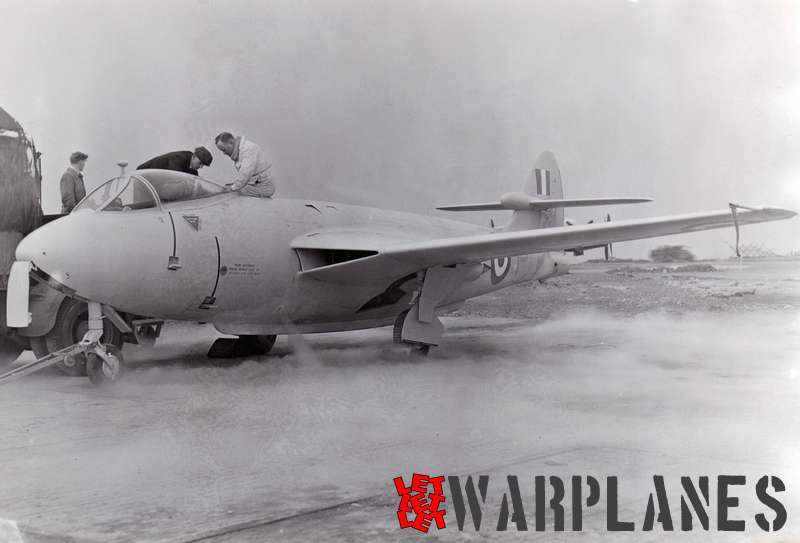
The P.1072 flew in general very well with the Snarler with a phenomenal rate of climb. Since the Snarler could not be stopped once fired the P.1072 had to be flown nose-up because of critical Mach number limitations. Maximum speed obtained during trials in a climb was Mach 0.86 at 9150 m which was equivalent to approx. 872 km/h. The final fate of VP401 remains unclear, but at some point it was scrapped.
Production and operational use:
VP401 was soon followed by the first fully navalized prototypes VP413 and VP422. The new Hawker fighter was dubbed as the ‘Sea Hawk’. They were fitted with folding wings, arrester hook and four nose-mounted 20 mm cannon.VP413 made its first flight on 3 September 1948; VP422 flew first on 17 October 1949. Meanwhile VP413 had successfully made its first deck landing trials on HMS Illustrious. In November 1949 Hawker received a contract to produce 151 aircraft as Sea Hawk F.Mk.1 .
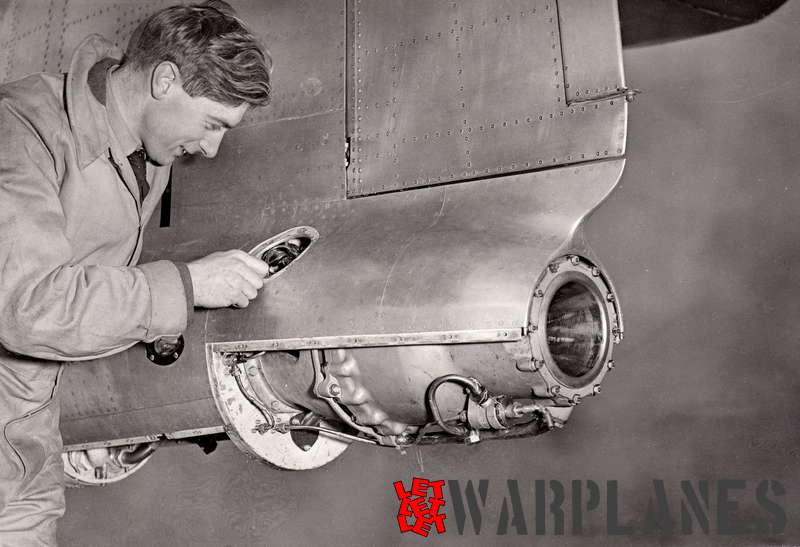
In fact only 95 were built of this first order. Hawker supplied the first batch of 35, but increasing demands on the new Hawker Hunter fighter resulted in the production being relocated to Armstrong Whitworth Aircraft at Baginton where all remaining Seahawks were built until production was terminated in the late fifties. Armstrong Whitworth also did all development work on the progressing versions of different marks. This included the installation of newer Nene types with more thrust, underwing extra fuel tank installation and strengthened points under the wings for bombs or rockets. Even when the production line at Baginton was already closed, Armstrong Whitworth had to reopen it over 1959-1960 for an additional production batch of 12 Seahawks F.G.A. 6 for the Indian Navy.
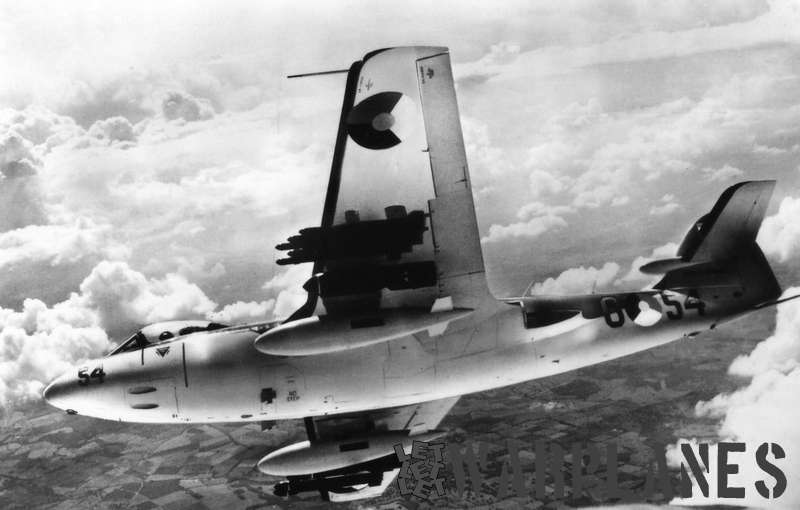
The following Sea Hawks were produced:
-VP401: P.1040 prototype (1)
-VP413 and VP422: Spec. N.7/46 prototypes (2)
-WF143-WF161; WF167 and WF177; WM901-WM905: Seahawk F Mk.1 (35 Built by Hawker)
-WF162-WF166; WF178-WF192; WF196-WF235: Sea Hawk F Mk.1 (60 built by Armstrong Whitworth)
-WF240-WF279: Sea Hawk F Mk.2 (40 built by Armstrong Whitworth)
-WF280-WF289; WF293-WF303; WM906-WM945; WM960-WM999; WN105-WN119: Sea Hawk F Mk. 3 (116 built by Armstrong Whitworth)
-WV792-WV807; WV824-WV871; WV902-WV922; XE327-XE338: Sea Hawk F.G.A. 4 (97 built by Armstrong Whitworth)
-XE339-XE344; XE362-XE411; XE435-XE463; XE490: Sea Hawk F.G.A. 6 (86 built by Armstrong Whitworth)
-Registration nos. 6-50 to 6-71: Sea Hawk Mk. 50 for Dutch Marineluchtvaartdienst (22 built by Armstrong Whitworth; although Francis Mason claims incorrectly in his book ‘Hawker aircraft since 1920’ that 32 were built)
-32 Sea Hawk Mk.100 day fighters for German Bundesmarine; 12 built by Armstrong Whitworth + 20 by Focke-Wulf at Bremen, Germany
-32 Sea Hawk Mk.101 all-weather fighters for Bundesmarine built by Focke-Wulf at Bremen.
-12 Sea Hawk F.G.A. Mk. 6 for Indian Navy built by Armstrong Whitworth.
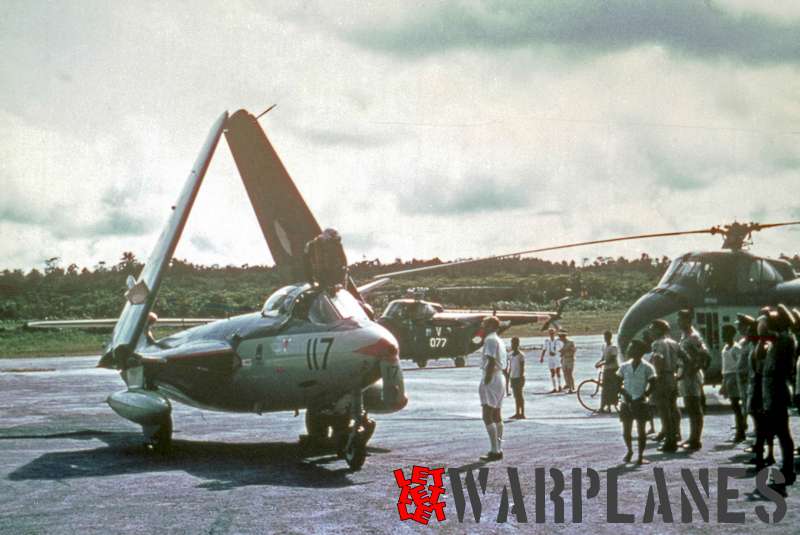
(Photo: Prudent Staal collection)
Total production:
38 by Hawker including the prototypes
445 by Armstrong Whitworth
52 by Focke-Wulf
Total number manufactured including the prototypes: 535.
The different production variants of the Sea Hawk were:
Sea Hawk F Mk. 1:
Production fighters powered by a Rolls-Royce Nene Mk 101 engine,
Sea Hawk F Mk. 2:
Production fighter with powered ailerons.
Sea Hawk FB Mk. 3:
Fighter-bomber variant with stronger wing for external stores.
Sea Hawk FGA Mk. 4:
Fighter/Ground attack variant.
Sea Hawk FB Mk. 5:
FB Mk. 3 fitted with the Nene Mk 103; 50 converted from production line.
Sea Hawk FGA Mk. 6:
FGA 4 with the Nene Mk 103; total of 101 (86 new-build, the remainder converted from FB3 and FGA 4 existing stock).
Sea Hawk Mk 50: Export variant based on the FGA 6 for the Dutch Marineluchtvaartdienst fitted with a Philips UHF radio system.
Sea Hawk Mk 100:
Export variant for the West German Navy, similar to FGA 6 but fitted with taller fin and rudder.
Sea Hawk Mk 101: All-weather export variant for the West German Navy, as Mk 100 but fitted with a search radar in an underwing pod.
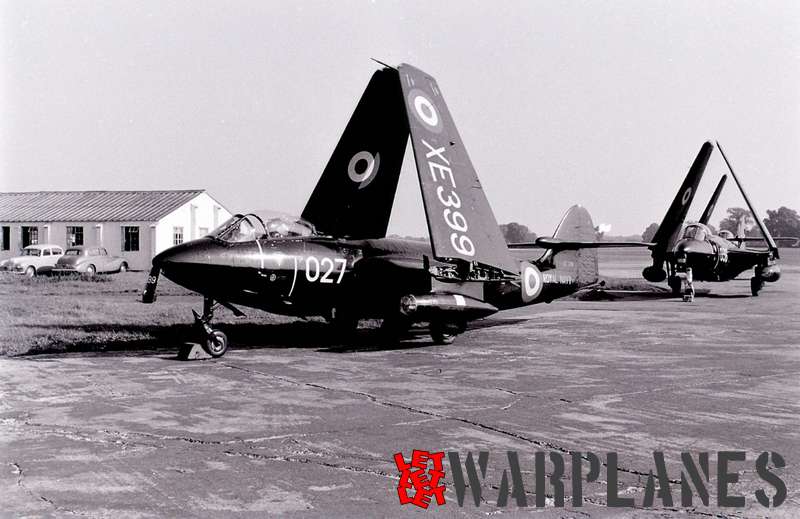
(Dave Smith collection)
The first production Sea Hawk F Mk.1 WF143 flew on 14 November 1951, fitted with a more powerful Nene 4 jet engine offering 2268 kg (5000 lbs) of thrust. The earlier Nene 1 only gave 1814 kg (4000 lbs).Also windscreen and cockpit canopy were restyled. Over the next years, all batches of Sea Hawks produced found their way to the Fleet Air Arm as standard fighter-bomber on board of aircraft carriers until they were replaced by the Vickers-Supermarine Scimitar. Sea Hawks were used operationally in the autumn of 1956 at the outbreak of the Suez-canal crisis. The Egyptian president Nasser had confiscated the Suez canal area in order to generate more money for his country. A combined military operation of British, French and Israeli forces under the name Operation Musketeer was the result. During this operation Sea Hawks loaded with bombs and rockets operated from the aircraft carriers HMS Eagle, Albion and Bulwark. The attacks on the Egyptian targets were operationally a great success, inflicting heavy damage to Egyptian war material. Strategically, however, Operation Musketeer was a disaster since the attacking forces had to accept a cease-fire under international pressure that finally resulted in a withdrawal of all U.K. forces!
At the Fleet Air Arm the Sea Hawks were maintained in front line duty until 1960 before being phased out.
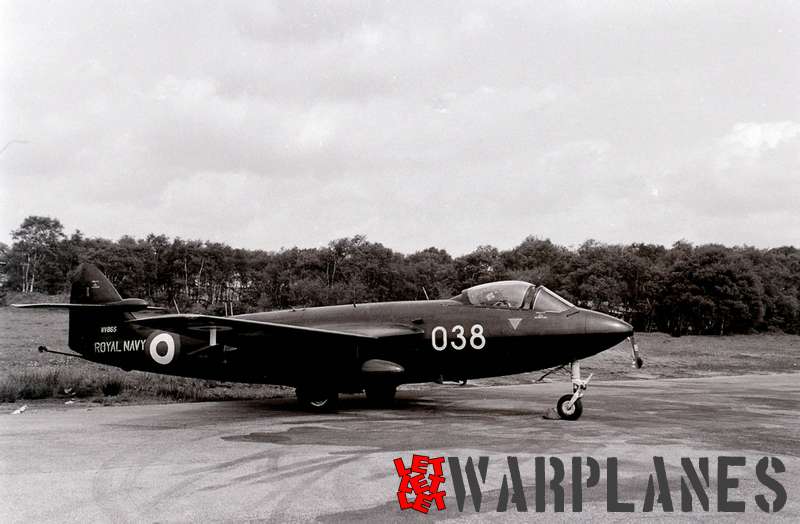
(Dave Smith collection)
Foreign users:
The Dutch MLD (Marineluchtvaartdienst) placed in 1956 an order for 22 Seahawk FGA Mk.50’s. These were broadly similar to the F.G.A. Mk.6, but on request of the MLD they were fitted with Philips UHF radio equipment. They served on the aircraft carrier Karel Doorman A small number was also used ashore in the Dutch West Indies, stationed at Hato, Curacao and on the Dutch Naval Air Station Valkenburg. In 1959 they were fitted with two Philco Sidewinder air-to-air missiles. The underwing pylons were designed and built by Fokker and the installation was funded by NATO. The Dutch Sea Hawks were phased out in 1964 and most of them were scrapped. They were not replaced by a new fighter type. Only two remain today in Dutch aviation museums.
Around the same time of the Dutch Sea Hawk order, also the German Kriegsmarine ordered the Seahawk. The first batch of 32 were Mk.100’s, also roughly similar to the F.G.A. 6 but adapted on a number of points to German requirements. The first 12 Mk.100’s were built by Armstrong Whitworth, but the remaining machines were all built by the Focke-Wulf works at Bremen. They were primarily intended as daylight interceptors
Another batch of 32 of a slightly different version, the Mk.101, was completely built by Focke-Wulf. They were intended as all-weather fighters. For this purpose they carried under one wing in a special pod an Ekco 34 search radar. Although the Kriegsmarine did not have an aircraft carrier in its fleet, the German Seahawks retained all their naval equipment like folding wings and arrester hook. When phased out in the sixties, they were replaced by a number of Lockheed F-104G Starfighters.
The last customer for the Sea Hawk was the Indian Navy. They ordered at Armstrong Whitworth in September 1959 a batch of 24 F.G.A 6 variants for their aircraft carrier INS Vikrant. Twelve were refurbished from Ex-F.A.A. machines, but the remaining other twelve were newly built and in fact Armstrong Whitworth had to reopen their production line for this order. Eventually, the Indian Navy ordered an additional 50 refurbished ex-F.A.A. Sea Hawks. The Indian Sea Hawks were used until the early eighties when they were replaced by another Hawker product, the Harrier. The Indian Sea Hawks were used in the armed conflict with Pakistan. They attacked Pakistani naval vessels without sustaining any losses.
Another lesser known customer of the Sea Hawk was the Australian Navy who used a small number of ex-F.A.A. machines.
Technical details (F.G.A. Mk. 6):
Power plant: 1 × Rolls-Royce Nene 103 turbojet, 5,200 lb (2359 kg) thrust
Dimensions:
-Length: 39 ft 8 in (12.09 m)
-Wingspan: 39 ft 0 in (11.89 m)
-Height: 8 ft 8 in (2.64 m)
-Wing area: 278 ft² (25.83 m²)
Weights:
-Empty weight: 9,278 lb (4,208 kg)
-Loaded weight: 13,220 lb (5,996 kg)
-Max take-off weight: 16,150 lb (7,325 kg)
Performances:
-Maximum speed: 600 mph (965 km/h)
-Range: 480 miles (770 km)
-Service ceiling: 44,500 ft (13,564 m)
-Rate of climb: 5,700 ft/min (29.0 m/s)
Armament:
-Guns: 4 × 20 mm (.79 inch) Hispano Mk V cannons (200 rpg)
-Hardpoints: 6 underwing and provisions to carry combinations of rockets 20 × “60 lb” (27 kg) unguided rockets or 16 × 5 inch (127 mm) unguided rockets
-Others: 4 × 500 lb (227 kg) bombs or 2 × 90 Imp gal (410 l) drop tanks
Crew: One
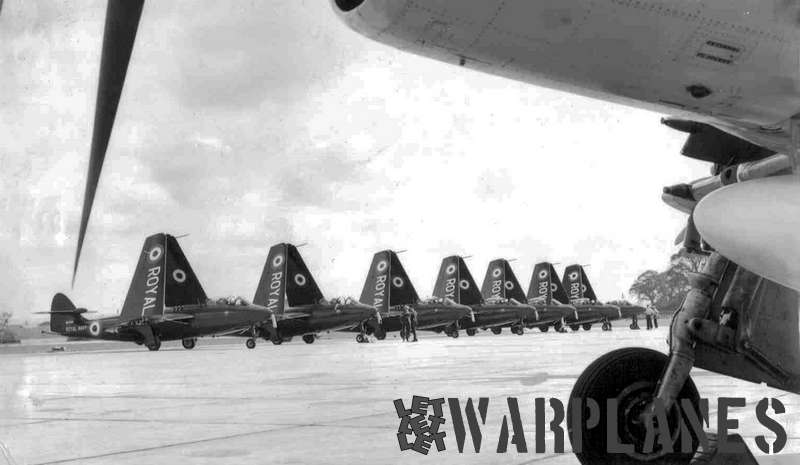
(Dave Smith collection)
Survivors:
36 complete Sea Hawks (plus eight cockpit sections) are known to survive as of 2011, mainly in a variety of locations in the United Kingdom, though others are located abroad, including in Germany, Malta, the Netherlands and India. One Sea Hawk, WV908, remains airworthy as part of the Fleet Air Arm’s historic flight in the UK, although refurbishing the aircraft including fitting a new Nene 103 took place in 2009.
–WF219 (Sea Hawk F 1) is stored at the Fleet Air Arm Museum, Yeovilton, England.
–WF225 (Sea Hawk F 1) is displayed as ‘gate guardian’ at RNAS Culdrose, England.
–WF259 (Sea Hawk F 2) is displayed at the National Museum of Flight, East Fortune, Scotland.
–WM913 (Sea Hawk FB 5) is displayed at the Newark Air Museum, Newark, England.
–WM961 (Sea Hawk FB 5) is displayed at Caernarfon Air World, Caernarfon, Wales.
–WM969 (Sea Hawk FB 5) is displayed in Hangar 3 at the Imperial War Museum, Duxford, England.
–WN108 (Sea Hawk FB 5) is stored by the Ulster Aviation Society at Long Kesh, Northern Ireland.
–WV797 (Sea Hawk FGA 6) is displayed at the Midland Air Museum, Coventry, England.
–WV798 (Sea Hawk FGA 6) (displayed until late 2009 at Lasham, England), is stored with Parkhouse Aviation at Booker, England.
–WV826 (Sea Hawk FGA 6) is displayed at the Malta Aviation Museum, Ta’qali, Malta.
–WV856 (Sea Hawk FGA 6) is displayed at Fleet Air Arm Museum, Yeovilton, England.
–WV865 (Sea Hawk FGA 6) is displayed at the Luftwaffe Museum, Gatow, Germany.
–WV908 (Sea Hawk FGA 6) is airworthy with the Royal Navy Historic Flight, Yeovilton, England.
–XE327 (Sea Hawk FGA 6) is displayed at Hermeskeil, Germany.
–XE340 (Sea Hawk FGA 6) (displayed until recently at the Montrose Air Station Museum, Scotland) returned to the FAA Museum, Yeovilton.
–XE489 (Sea Hawk FGA 6) is displayed at the Gatwick Air Museum, Charlwood, England.
–‘118’ (Sea Hawk Mk 50) is displayed at the Traditiekamer Museum at De Kooy, Netherlands.
–‘130’ (Sea Hawk Mk 50) is displayed at Kamp Zeist, Militaire Luchtvaart Museum(MLM) Netherlands. Earlier it was displayed in the Aviodome museum at Schiphol airport.
–MS+001 (Sea Hawk Mk 100) is displayed at Internationales Luftfahrt-Museum, Villingen-Schwenningen, Germany.
–IN-174 (Sea Hawk FGA 6) is displayed at Jawahar Bal Bhavan, Museum Road, Trivandrum, Kerala, India.
–IN-240 Sea Hawk is displayed at the Victory at Sea Memorial, Beach Road, Visakhapatnam, Andhra Pradesh, India
(From Wikipedia)
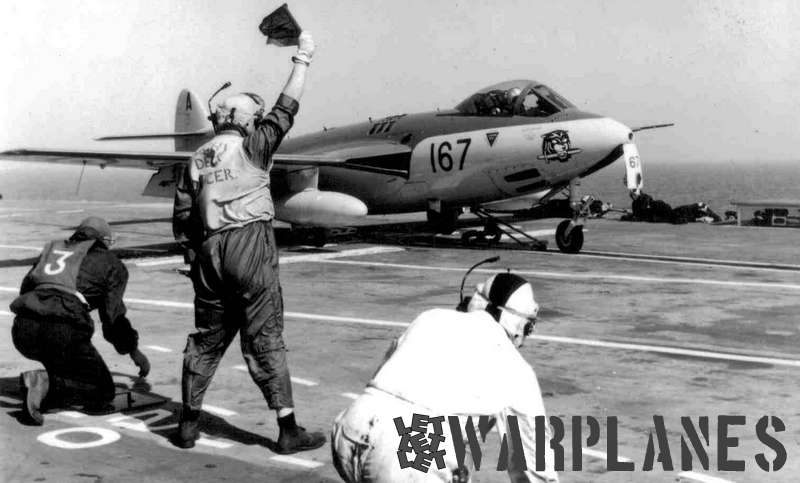
(Dave Smith collection)
References:
-Derek N. James, Hawker -an aircraft album, Ian Allan U.K.1972
-Francis K. Mason, Hawker aircraft since 1920, Putnam U.K. 3rd edition 1991
Remarks:
-If the Hawker P.1040 would have been purchased by the R.A.F. it would have been known as the Hawker ‘Hawk’. The R.A.F. finally got many years later its (other) Hawk; a design from Hawker Siddeley as the company was mentioned by that time. When taken into production, Hawker Siddeley had meanwhile merged into the British Aircraft Corporation, later renamed into British Aerospace.
-Two Sea Hawks from the production line were extensively modified for swept wings research as the P.1052 and P.1081. They were given serial nos. VX272 and VX279 .
-The Sea Hawk could be started electrically. However, it also had a special Plessy starter on board fitted with Cordite explosive cartridges.
When a cartridge was used to start up the Nene engine, it produced a large and very characteristic wreath of smoke from an opening on one side of the mid fuselage.
Nico Braas
All photographs: Letletlet collection unless stated otherwise.



















